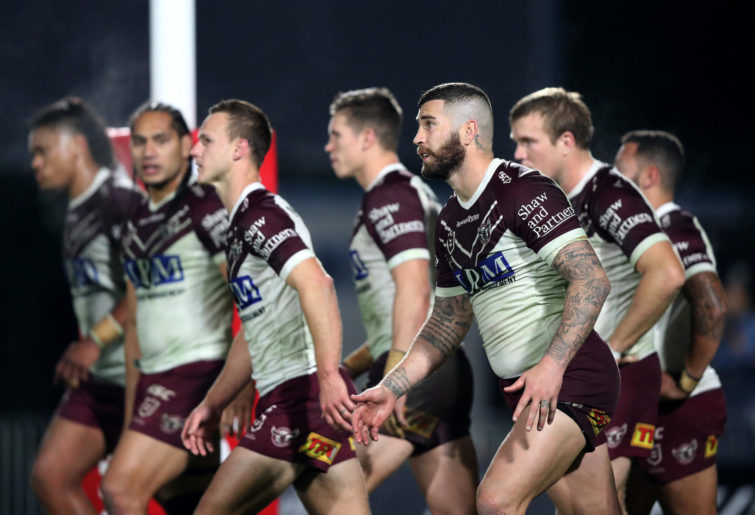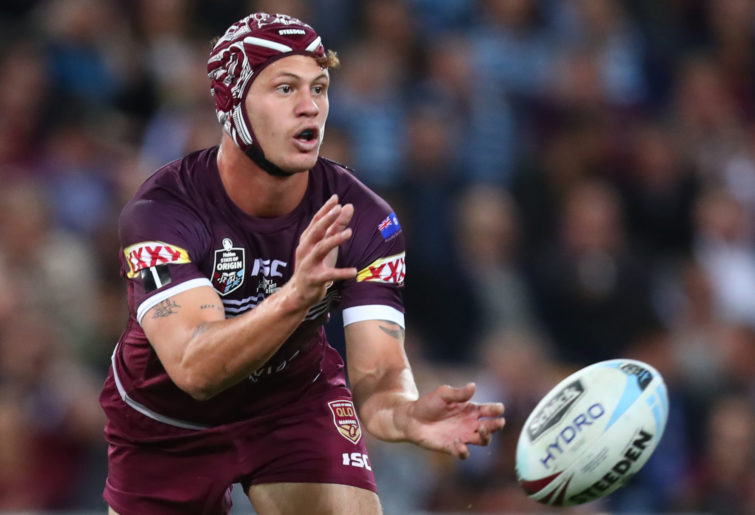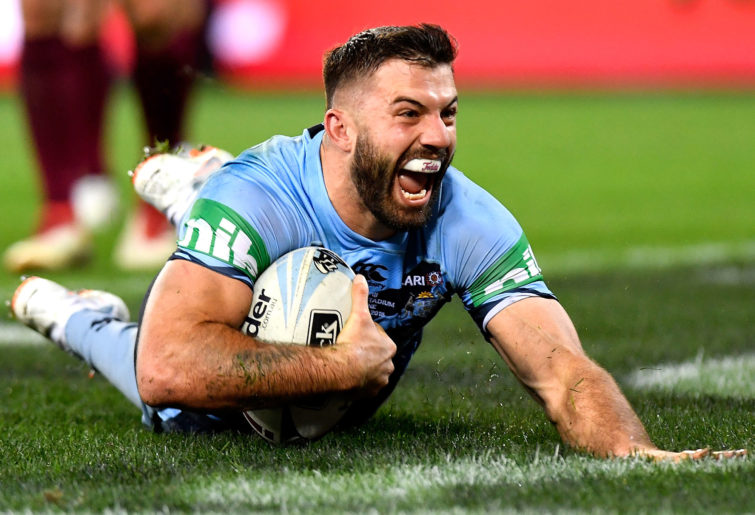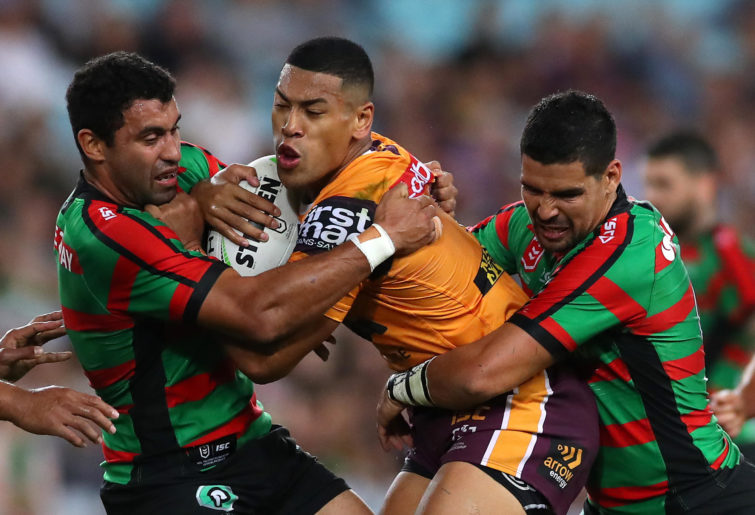NRL Round 7 judiciary: Roosters star duo charged
James Tedesco will be free for the next game of the Sydney Roosters' inconsistent NRL campaign after escaping suspension for tripping Ryan Papenhuyzen. The…
How do you fix a game that doesn’t acknowledge it requires fixing?
Like all things, first you must admit you have a problem, and the NRL has one. So instead of recycling the same old rhetoric around how to fix the NRL, I’ve got some better ideas to expand the game.
Like all NRL fans who have ever sat down with their mates and had a good hard sook about their beloved but beleaguered game, here are the audacious ideas I’d like to see the NRL consider for their own sake and the sake of the fans. Think of the children!
1. Interchange rules
First cab off the rank is to change interchange rules to reduce the number of players on the first-grade roster, thereby reducing the financial burden on teams and increasing fatigue, which will lead to reduced injuries and more open, non-structured play.
We should have four players on the interchange bench and two spare for head injuries, who will be called upon by an independent NRL doctor. This sideline doctor will decide who should be subbed by watching replays. This could also help develop the ‘captains call’ system with the referees reviewing critical calls, but this would have to be done without removing the fatigue element.
Changing the interchange will force teams to pick rosters that are more diverse and skillful as opposed to just having cloned giants running with impunity and then being subbed for another giant who just does the same thing. Boring.

(Hannah Peters/Getty Images)
2. Weight limits for the forward pack and backs
You could say that there should be an average weight of 107.5 kilograms per forward, so a pack total of 645 kilograms with a maximum single-player weight of 115 kilograms. This way you can’t just stack a team full of giant youngsters on cheap contracts with minimal skills and no heart or answers once they run into their first large seasoned man for the first time. The backs could have an average weight of 97.5 kilos per player.
I get the impression that some ‘amazing’ plays we all crap on about aren’t actually that amazing at all – it’s just that we aren’t used to seeing that stuff happen in first grade these days. Many players made it into first grade because they were bigger when they were teenagers, not necessarily better players per se.
This would open the door to proper coaching tactics and allow pathways for smaller, physically slower developing players – who are usually more skillful but don’t mature until they are in their early 20s – to establish themselves in the NRL and remain competitive until they are physically ready.
Let’s be honest, at the moment we lose our minds over Kalyn Ponga, but there are 70-kilo to 80-kilo guys in Toronto and Coffs Harbour doing what he does week in and week out but who were never considered for NRL because they weren’t 100 kilos at 13 years old.
There are surely so many Johnathan Thurstons out there; they just need to see a way forward. At the moment, unless you hit the weights at a young age – which is bad for your development – there is little chance for a kid who physically develops more slowly.

(Chris Hyde/Getty Images)
3. Players must play in their numbered positions
The only exception is if the captain informs the referee of positional changes. This means that in a scrum forwards must play their positions. Rugby league will continue to be a joke until this at least is fixed. The hooker must take taps after a kick for touch. The halfback must feed the scrum. It should be more like union – make it more professional. Learn from rugby’s mistakes but learn from its international appeal.
4. Simpler scrums
Don’t make them more complicated, just make them a competition. And once we fix my next point, there will be fewer scrums anyway.
5. Knock-ons and forward passes
Seriously. It’s almost a joke now. Actually, it’s been a joke for years now. The ball must leave the hands forwards or towards the opponent’s touchline. Let the game flow, let fatigue build, let open unstructured play flourish. Let tries be scored! This is what fans come to see. They come to see Ponga and James Tedesco jink and step and wrap around and sprint and then pick out a tired larger forward, draw and pass, offload and – boom! – try time. It’s amazing TV, amazing entertainment and everyone’s happy.
Also, it’s 2019 – I know this is Australia and we are ten years behind the rest of the world, but I’m sure there were GPS trackers in 2009 that could be put in a ball to track exactly everything in real time. Get with the program.

(Bradley Kanaris/Getty Images)
6. An external audit of the game
A complete and comprehensive external audit of all aspects of the game and NRL by an American NFL-affiliated sports organisation. The NRL is like a bunch of academics who have only sat in the same room with the same old mates for decades. It’s time to clean out the old heads and get some outside influence into the running of the game without losing the core spirit of what rugby league is – or should be, which is a game that everyone should be able to play and enjoy at all levels.
The NRL needs a standards department that demands teams conduct their business in a certain way to maintain a minimum professional standard, as is the case in the AFL. I keep using the AFL as a standard, but as sad as it sounds as an NRL fan, the AFL, even with their faults, is the standard at the moment for how a sporting administration should treat its teams, players and fans.
7. Restructure the junior pathways
And I mean a complete restructure. Weight classes, not for the small kids, but for the bigger kids. They need it badly. Look at the All Blacks, who have had weight classes in junior rugby for decades. Their problem is that there are many larger junior players who can run over everyone, so they make sure they focus on skills and development as opposed to just picking the biggest players, granting them quick citizenship if they aren’t citizens and then throwing them to the wolves.
Also, if you haven’t noticed, many of the All Blacks players are not giant Fijians or Pacific Islanders but players of a mix of backgrounds. And who’s their best player? A small Pakeha guy who would have been overlooked in Australia for some bigger Pacific Islander who had been an Australia since breakfast time. They understand that certain players develop later in life and that development time doesn’t determine by the age of 16 whether they’re going to cut it.
The NRL is missing out on so much talent because of the obsession with these big kids, who we throw all this money at when they are 18 only to find they can’t run over grown men like they did kids. Then, inversely, you get the little kids who were run over each and every time but who grow up bigger and smarter and can beat the previously bigger boys, and because they hadn’t been flogged by first-grade rugby since the age of 17, they’re in better condition.
Case in point: Reuben Garrick for Manly. But then look at Jorge Taufua. If Taufua wasn’t a brick on legs, he wouldn’t be in first grade at all. He has basic skills now he’s been in the NRL for ages, but he’s only good because he’s big and was picked up young. Garrick is in his first year in the NRL at 22 but he’s playing like a veteran with absolute confidence and has skills Taufua can only dream of.
We need to change the paradigm around what age players should start. The age of 18 is too young and is making it hard for families to justify sending their kids to the slaughter each weekend at the hands of 100-kilo, eight-year-old ‘kids’. It’s killing the game slowly but surely. It does nothing for the large kid and nothing for the smaller kid, and anyone who says otherwise is wrong.
I’m not saying we shouldn’t expose smaller players to larger players; I’m just saying that if a kid spends his whole life getting battered by a kid who’s 60 kilos larger than him – which would never happen in any other sport in the world! – it can’t be healthy. The smaller kid will end up playing grass ballet and the large kid will never develop any true skill.

(Mark Kolbe/Getty Images)
8. Contract limits
Players shouldn’t sign contracts more than four years at a time and it should be illegal for clubs, managers or players to talk about contracts until the end-of-season trade window in the last year of their contract. Players can only break contract under very strict circumstances – for personal reasons or club financial issues, and the NRL must approve it. A contract is a contract.
The NRL will determine the maximum yearly salary a club can pay a player in their first four rookie years, so instead of players just choosing based on who can throw the most money at them, clubs will have to compete with facilities, trainers, coaches, opportunities, third-party income, housing et cetera. Or, if a contract is over a certain amount, it’s held in abeyance until the player has played over a certain number of games or reaches a certain time period playing NRL. A full trade window would also work.
How is it fair that a player on $100,000 per year lives in Brisbane with a cost of living much lower than a player on the same wage living in Manly or Bondi or Melbourne? It’s a joke.
9. Develop a loyalty program
Once a player has been at a club for more than ten years, including junior development time – for example, Tom and Jake Trbojevic – they have a salary cap discount. This would help keep home-grown players at clubs that developed them. Considerations would be made for clubs with little or no junior programs.
There should also be a players swap or trial program like in the EPL whereby you can send your young talent to another club for first-grade experience if an opportunity were to open up. If you look at how the EPL does it, it works and helps foster good players getting while releasing thos not up to scratch. Look at how the AFL does it too – it works, and the NRL would be stupid not to follow suit. This way Ponga could have stayed with North Queensland but spent two years developing at Newcastle while Thurston finished up.
That way Kalyn would have come back with two years of experience under his belt to finish off his contract at North Queensland – or there would have been a buyout option whereby Newcastle could have paid a huge transfer fee to buy him. I think a player-manager code of conduct would stop lots of the contract issues we have in the NRL.
10. Review dangerous contact
Any contact with the head is carded, like in rugby union. It has to stop. All the commentators who are former players bang on about it, contradict themselves and then are outraged when a referee bins someone for it. Any contact with the head is illegal contact, whether you’re a tackler or taking a hit up. If you raise your elbow and it makes contact with the neck or head in any way, it’s a penalty. Obviously the referee can use discretion – if it’s a cynical foul, it’s an automatic yellow or red card for five or ten in the bin.
This also goes for the ugly spectacle that is the collar fling. Again, it’s dangerous and teaches poor technique. In rugby union it’s illegal because it’s considered part of the neck, and they’re right. The NRL needs to end collar grabs now.
They also need to ban entering a tackle by diving at legs or back once a player is already bound by other players. Again, like rugby, the NRL needs to bring in a ‘cynical foul’ rule so referees have the discretion to give penalties based on whether they think a player deliberately tried to cause an injury. It works really well in rugby, but we see the lack of this rule exploited weekly in the NRL.
We must protect smaller players. Idiots who like to ‘smash’ smaller players with no repercussions should be automatically binned for ten. If they cause that player to leave the field for a head injury assessment, they too must be replaced for the 15 minutes at the expense of one of their interchanges, of which there are only 6. Again, if it keeps up, it’s the captain who will get ten minutes. What responsibility does a captain of a team have at the moment? None. He gets to jaw off to the referee with impunity. This has to change.

(Cameron Spencer/Getty Images)
11. Professional fouls
Imagine this: Melbourne have already given away two or three penalties on their try line and the attacking team needs more than two points to win – and Cam Smith is getting away with murder and is instructing his team to lay in the ruck and keep getting penalties. The referee has warned Melbourne, but they keep on doing it. This time, Nelson Asofa-Solomona comes out early and whacks someone and is called offside. The referee calls over Smith and Solomona and gives Solomona five in the bin for a professional foul, then he gives Smith ten in the bin for a team ‘captain penalty’ or ‘team foul’. If you keep stuffing up and playing negative footy, the captain gets binned. Simple.
12. Professional conduct
Players should have to call the referee ‘sir’. No exceptions. If anyone besides the captain gives lip to the referee, they’re within their rights to bin that player without a need to explain themselves. This goes both ways. Referees and officials, video referees included, need to start using the players’ numbers when conducting official business in game. For example, if the referee was calling out a player to red-card them, like in rugby, they would say: “Melbourne captain and your No. 10”. They would approach the referee, not argue with them, and the referee would explain what happened before pulling out the red card and sending the No. 10 on his way. Simple.
The captain has the right to ask for clarification if he’s respectful, but the referee also has the right to tell him to go away and get on with the game. Many a time captains just argue to waste time and let their team rest, so the referee’s discretion will be important if this is to work. But it’s respectful. It’s professional. It’s how the rest of the world does it for those reasons. The NRL sits there and complains about how the referees are so hard done by – well, empower them!
13. Add two more clubs
We need a combined Country NSW team based out of four New South Wales country towns and also a club in Perth. This would probably run at a loss, but like the AFL, if you are prepared to stick to your guns and have a solid plan in place, you can have a team like the Melbourne Storm – or you can have a team like the Titans. I’d also move the Titans to Toowoomba or Ipswitch and call them the Western Queensland Bulls. Another team could be deployed in Gosford as it’s a huge rugby league area. They should play home games in the Northern Rivers region.
14. Hire a new marketing team from the USA
After decades of poor ads, missed opportunities, embarrassing media gaffes and pathetic grand final and State of Origin entertainment, among other things, I think its time for the NRL to scrap the old ideas and bring in something fresh, new and global – again, get the AFL or NFL people to show you how to do it. Or me. I’ll help the NRL get to where we all want it to be.